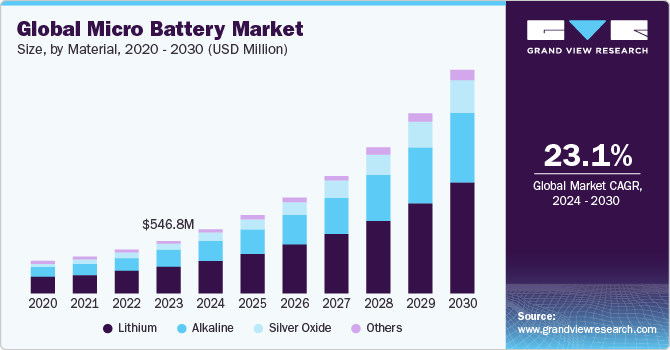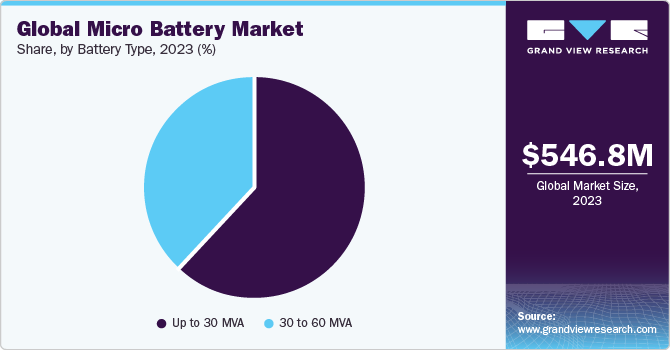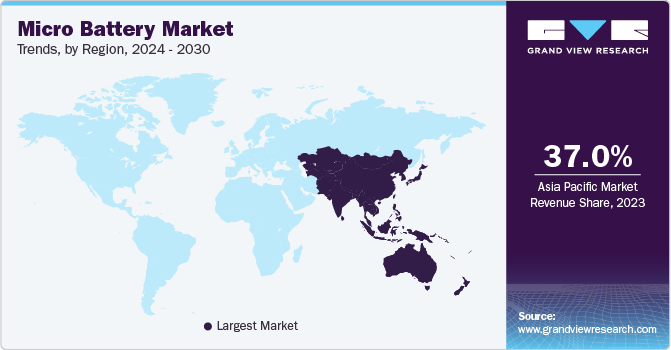- Home
- »
- Power Generation & Storage
- »
-
Micro Battery Market Size, Share, Growth Report, 2030GVR Report cover
![Micro Battery Market Size, Share & Trends Report]()
Micro Battery Market Size, Share & Trends Analysis Report By Material (Alkaline, Silver Oxide, Lithium, Others), By Type (Thin Film Batteries, Printed Batteries), By Capacity, By Battery Type, By Region, And Segment Forecasts, 2024 - 2030
- Report ID: GVR-4-68040-262-8
- Number of Report Pages: 220
- Format: PDF, Horizon Databook
- Historical Range: 2018 - 2022
- Forecast Period: 2024 - 2030
- Industry: Energy & Power
Micro Battery Market Size & Trends
The global micro battery market size was estimated at USD 546.8 million in 2023 and is expected to expand at a CAGR of 23.1% from 2024 to 2030. The market is flourishing due to a confluence of trends miniaturizing devices and demanding reliable power sources. Consumer electronics like smartphones, smartwatches, and hearing aids are constantly shrinking in size. This necessitates smaller power sources that pack a punch, making micro batteries perfectly suited for these applications.

Environmental concerns are driving a shift towards eco-friendly batteries. The market is seeing a rise in rechargeable options and research on biodegradable materials. Additionally, efficient manufacturing processes that minimize waste are becoming increasingly important factors for manufacturers.
Growing network of interconnected devices known as the Internet of Things (IoT) relies heavily on micro batteries. These miniature power sources are essential for powering sensors, trackers, and other devices that make up the vast network of the IoT.
Advancements in battery technology hold immense potential for the market. Areas of focus include solid-state chip batteries with higher energy density and printed batteries that can be integrated directly into devices for a more streamlined design. These innovations promise longer battery life and more efficient power delivery for micro-powered electronics.
Market Concentration & Characteristics
The market is a dynamic and competitive space with established players and innovative newcomers vying for dominance. Also, the industry is facing fierce competition from established players in various sectors. Leading companies like Cymbet Corporation, Enfucell, Blue Spark Technologies, Front Edge Technology, Inc. contribute significantly with their expertise in novel product launch, facility expansion, and technological development.

Alongside established players, niche players focusing solely on micro battery solutions are gaining ground. Companies like Riot Energy Inc. (U.S.) and Solid Power (U.S.) offer specialized micro battery products for specific application.
Companies operating in the space are increasingly focusing on launching innovative products in order to penetrate in the space. For instance, in January 2024, Betavolt, a Chinese startup launched a coin-sized micro battery that is able to generate electricity for 50 years without any need for charging.
Material Insights
Lithium dominated the market with the largest revenue share of around 51.28% in 2023. Lithium-ion batteries pack a significant amount of energy into a tiny package. This is crucial for micro batteries, where size constraints are paramount. Compared to other chemistries, lithium offers more power per unit volume, allowing for slimmer and lighter devices. Lithium batteries boast extended shelf life, meaning they can hold a charge for longer periods when not in use. Additionally, they exhibit minimal self-discharge, minimizing power loss over time. This is essential for micro batteries used in wearables and other devices that might not be in constant operation.
The alkaline segment is anticipated to grow at the fastest rate over the forecast period. Alkaline batteries are generally cheaper to produce compared to Lithium-ion counterparts. This makes them an attractive option for low-cost, single-use devices like remote controls, children's toys, or disposable medical sensors.
Battery Type Insights
The primary micro battery segment dominated the market with the largest share in 2023. This trend aligns with the exceptional shelf life, and extended stored periods without significant power loss. This makes them ideal for applications like smoke detectors, remote controls, and medical devices like pacemakers, where reliable power delivery is crucial, even after years of storage.

Widespread adoption of portable chargers and wireless charging solutions creates a perfect environment for the secondary micro battery segment. The ease of charging these batteries on the go or using readily available charging pads further enhances their user convenience and drives market growth.
Type Insights
Button batteries emerged as the largest segment in 2023 and is expected to register the highest growth over the forecast period. Miniaturization trend in consumer electronics like smartwatches, hearing aids, and remote controls creates a perfect fit for button batteries. Their compact size allows for sleek product designs without sacrificing power. The sheer volume of these devices across the globe translates to a massive and ever-growing demand for button batteries.
Button batteries find application in medical devices like pacemakers and hearing aids, where miniaturization and reliable power delivery are crucial. The Internet of Things (IoT) also creates new opportunities for button batteries, powering sensors, and trackers that form the backbone of this interconnected world.
Capacity Insights
The 10 mAH to 100 mAH segment dominated the market with the largest share in 2023. The ever-increasing popularity of wearables like smartwatches, fitness trackers, and health monitors creates a significant demand for micro batteries in the 10 mAh to 100 mAh range. These devices require enough power to last throughout the day while remaining comfortable and lightweight on the user's body. The 10 mAh to 100 mAh capacity segment offers the perfect balance between functionality and size for these applications.
The above 100 mAh micro battery segment is expected to register the highest growth over the forecast period. The 100 mAh capacity segment offers the extended runtime needed for these functionalities, allowing wearables to transition from simple trackers to sophisticated health and fitness companions.
Regional Insights
The North American micro battery market is experiencing a surge, fueled by the miniaturization trend across various industries. Rise of smartwatches, fitness trackers, and other wearable electronics is a major driver. These gadgets require compact, yet long-lasting batteries, propelling the demand for micro batteries. Additionally, the growth of the Internet of Things (IoT) with its network of interconnected devices further fuels the market as these devices often rely on micro batteries for power. The North American micro battery market is expected to witness significant growth in the coming years. With the increasing focus on miniaturization, sustainability, and the constant development of new applications, micro batteries are poised to play a vital role in powering the future of electronics.

U.S. Micro Battery Market Trends
The micro battery market in the U.S.is expected to grow at a CAGR of 24.9% from 2024 to 2030. Americans are embracing wearable technology at an increasing rate. Fitness trackers, smartwatches, and other wearables are becoming ubiquitous, creating a massive market for micro batteries. The need for reliable, long-lasting power sources to fuel these devices is a significant driver for the U.S. micro battery market.
Asia Pacific Micro Battery Market Trends
The micro battery market in Asia Pacific accounted for a global share of about 37.0% in 2023. The region is likely to dominate industry over the forecast period. Asia Pacific is a global hub for electronics manufacturing, boasting major players like China, South Korea, and Taiwan. This concentration of manufacturing expertise fosters a strong ecosystem for micro battery development and production. Additionally, the region's burgeoning middle class with a growing disposable income fuels a surging demand for consumer electronics like smartphones, wearables, and smart home devices - all of which rely on micro batteries.
The China micro battery market held a dominant share of about 30.0% in the Asia Pacific region in 2023. China is a global leader in electronics manufacturing, churning out a vast array of devices like smartphones, wearables, and IoT sensors. This robust manufacturing ecosystem creates a massive internal demand for micro batteries to power these devices.
The micro battery market in India is anticipated to register a CAGR of about 28.0% over forecast period. India’s growing middle class and increasing disposable income are driving a significant rise in consumer electronics purchases. Smartphones, wearables, and other electronic devices all require micro batteries, creating a vast and rapidly expanding market.
The South Korea micro battery market is anticipated to register a CAGR of about 22.5% in the Asia Pacific region over the forecast period. South Korea possesses a robust manufacturing ecosystem perfectly suited for micro battery production. The presence of skilled labor, established supply chains, and advanced infrastructure allows companies to efficiently manufacture high-quality micro batteries at scale.
Europe Micro Battery Market Trends
The micro battery market in Europe is experiencing a dynamic shift, driven by a confluence of technological advancements, environmental concerns, and a growing appetite for connected devices.
The Germany micro battery market held around 42.0% share in the European market due to confluence of factors specific to the German landscape and the broader European market. Germany is a leader in adopting Industry 4.0, a movement towards intelligent automation and digitalization of manufacturing processes. This translates into a growing demand for micro batteries to power the vast network of sensors, trackers, and other connected devices within these smart factories.
The micro battery market in UK is anticipated to grow at a CAGR of around 24.0%. This growth can be attributed to a rapid rise in the adoption of IoT technologies. Smart homes, connected factories, and intelligent infrastructure initiatives all rely on a network of sensors and devices powered by micro batteries. The need for reliable, long-lasting power sources in these applications is driving the demand for high-quality micro batteries within the UK.
The France micro battery market is expected to grow at a significant rate of 21.7% over the forecast period. The French government actively supports research and development in key technological areas, including micro battery technology. This translates into funding for innovative projects exploring new materials, advanced chemistries, and improved manufacturing processes.
Key Micro Battery Company Insights
The market is moderately consolidated with presence of a sizable number of small, medium and large-sized companies. The micro battery market is a dynamic landscape with established players in the battery space and innovative startups. Key companies are adopting several organic and inorganic growth strategies, such as new technological development, product launch, research & development, mergers & acquisitions, and joint ventures, to maintain and expand their market share.
-
In January 2024, Betavolt introduced innovative micro battery of size 15*15*15 millimeters and produces 100 microwatts of power at 3 volts.
-
In October 2023, Ensurge Micropower signed an agreement with a medical-device manufacturer for its solid-state lithium micro battery technology. The novel technology shall cater to the needs of portable medical devices for faster charging capabilities.
-
In May 2022, POSCO Holdings entered into an agreement with ProLogium for the development and supply of cathode, anode and solid electrolyte materials needed for the production of ProLogium’s next-generation solid-state batteries.
Key Micro Battery Companies:
The following are the leading companies in the micro battery market. These companies collectively hold the largest market share and dictate industry trends.
- Cymbet Corporation
- Blue Spark Technologies
- Front Edge Technology, Inc.
- Enfucell Oy
- Panasonic Corporation
- Molex
- TDK Corporation
- Shenzhen Grepow Battery Co. Ltd.
- VARTA AG
- Murata Manufacturing Co., Ltd.
Recent Developments
The micro battery market is prevailing with activity as companies race to develop smaller, more powerful batteries for powering the next generation of miniaturized devices. Here's a look at some exciting recent developments:
-
In January 2024, Betavolt unveiled a micro battery measuring 15,1515 millimeters. While the power output is modest (100 microwatts at 3 volts), it caters to applications with minimal power needs.
-
In September 2022, Maxell launched the PSB401515H, a high-capacity solid-state micro battery. This technology offers advantages like increased durability and safety compared to traditional lithium-ion batteries.
Micro Battery Market Report Scope
Report Attribute
Details
Market size value in 2024
USD 665.3 million
Revenue forecast in 2030
USD 2.3 billion
Growth rate
CAGR of 23.1% from 2024 to 2030
Base year
2023
Historical data
2018 - 2022
Forecast period
2024 - 2030
Quantitative units
Revenue in USD million/billion; and CAGR from 2024 to 2030
Report coverage
Revenue forecast, competitive landscape, growth factors and trends
Segments covered
Material, type, capacity, battery type, region
Regional scope
North America; Europe; Asia Pacific; Central & South America; Middle East & Africa
Country Scope
U.S.; Canada; Mexico; Germany; UK; France; Spain; China; India; South Korea; Australia
Key companies profiled
Cymbet Corporation; Panasonic Corporation; STMicroelectronics; Blue Spark Technologies; Jenax Inc.; Prologium technology Co. ltd; Front Edge Technology Inc.; Imprint Energy Inc.; Ultralife Corporation; Front Edge Technology; Inc.; Panasonic Corporation; Molex; TDK Corporation; Shenzhen Grepow Battery Co. Ltd.; VARTA AG; Murata Manufacturing Co., Ltd.; Renata SA; Duracell Inc.; Maxell Holdings Ltd.
Customization scope
Free report customization (equivalent up to 8 analyst’s working days) with purchase. Addition or alteration to country, regional & segment scope
Pricing and purchase options
Avail customized purchase options to meet your exact research needs. Explore purchase options
Global Micro Battery Market Report Segmentation
This report forecasts revenue growth at global, regional, and country levels and provides an analysis of the latest industry trends in each of the sub-segments from 2018 to 2030. For this study, Grand View Research has segmented the global micro battery market report based on material, type, capacity, and battery type, and region:
-
Material Outlook (Revenue, USD Million, 2018 - 2030)
-
Alkaline
-
Silver Oxide
-
Lithium
-
Others
-
-
Type Outlook (Revenue, USD Million, 2018 - 2030)
-
Thin Film Batteries
-
Printed Batteries
-
Solid-state chip Batteries
-
Button Batteries
-
-
Capacity Outlook (Revenue, USD Million, 2018 - 2030)
-
Below 10 mAH
-
10 mAH to 100 mAH
-
Above 100 mAH
-
-
Battery Type Outlook (Revenue, USD Million, 2018 - 2030)
-
Primary
-
Secondary
-
-
Regional Outlook (Revenue, USD Million, 2018 - 2030)
-
North America
-
U.S.
-
Canada
-
Mexico
-
-
Europe
-
Germany
-
UK
-
France
-
Spain
-
-
Asia Pacific
-
China
-
India
-
South Korea
-
Australia
-
-
Central & South America
-
Middle East & Africa
-
Frequently Asked Questions About This Report
b. The global micro battery market size was estimated at USD 546.8 million in 2023 and is expected to reach USD 665.3 million in 2024.
b. The global micro battery market is expected to grow at a compound annual growth rate of 23.1% from 2024 to 2030 to reach USD 2.3 billion by 2030.
b. Based on material, lithium was the dominant segment in 2023 with a share of about 51.0% in 2023. This is attributable due to as lithium offers more power per unit volume, allowing for slimmer and lighter devices. Lithium batteries boast extended shelf life, meaning they can hold a charge for longer periods when not in use.
b. Some of the key players operating in this industry include Cymbet Corporation, Panasonic Corporation, STMicroelectronics, Blue Spark Technologies, Jenax Inc., Prologium technology Co. ltd, Front Edge Technology Inc., Imprint Energy Inc., Ultralife Corporation, among others.
b. Consumer electronics like smartphones, smartwatches, and hearing aids are constantly shrinking in size. This necessitates smaller power sources that pack a punch, making micro batteries perfectly suited for these applications.
Share this report with your colleague or friend.
![gvr icn]()
NEED A CUSTOM REPORT?
We can customize every report - free of charge - including purchasing stand-alone sections or country-level reports, as well as offer affordable discounts for start-ups & universities. Contact us now
![Certified Icon]()
We are GDPR and CCPA compliant! Your transaction & personal information is safe and secure. For more details, please read our privacy policy.
We are committed towards customer satisfaction, and quality service.
"The quality of research they have done for us has been excellent."





